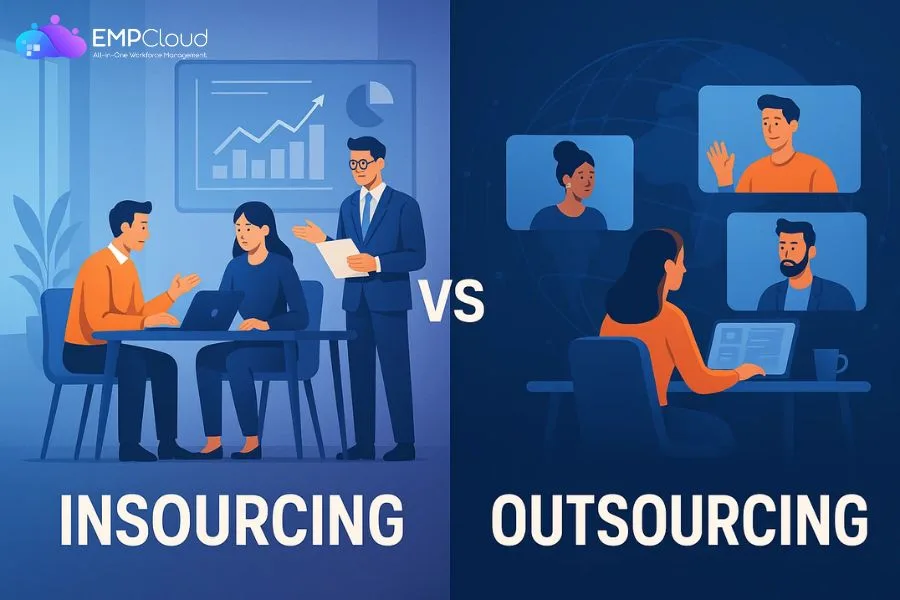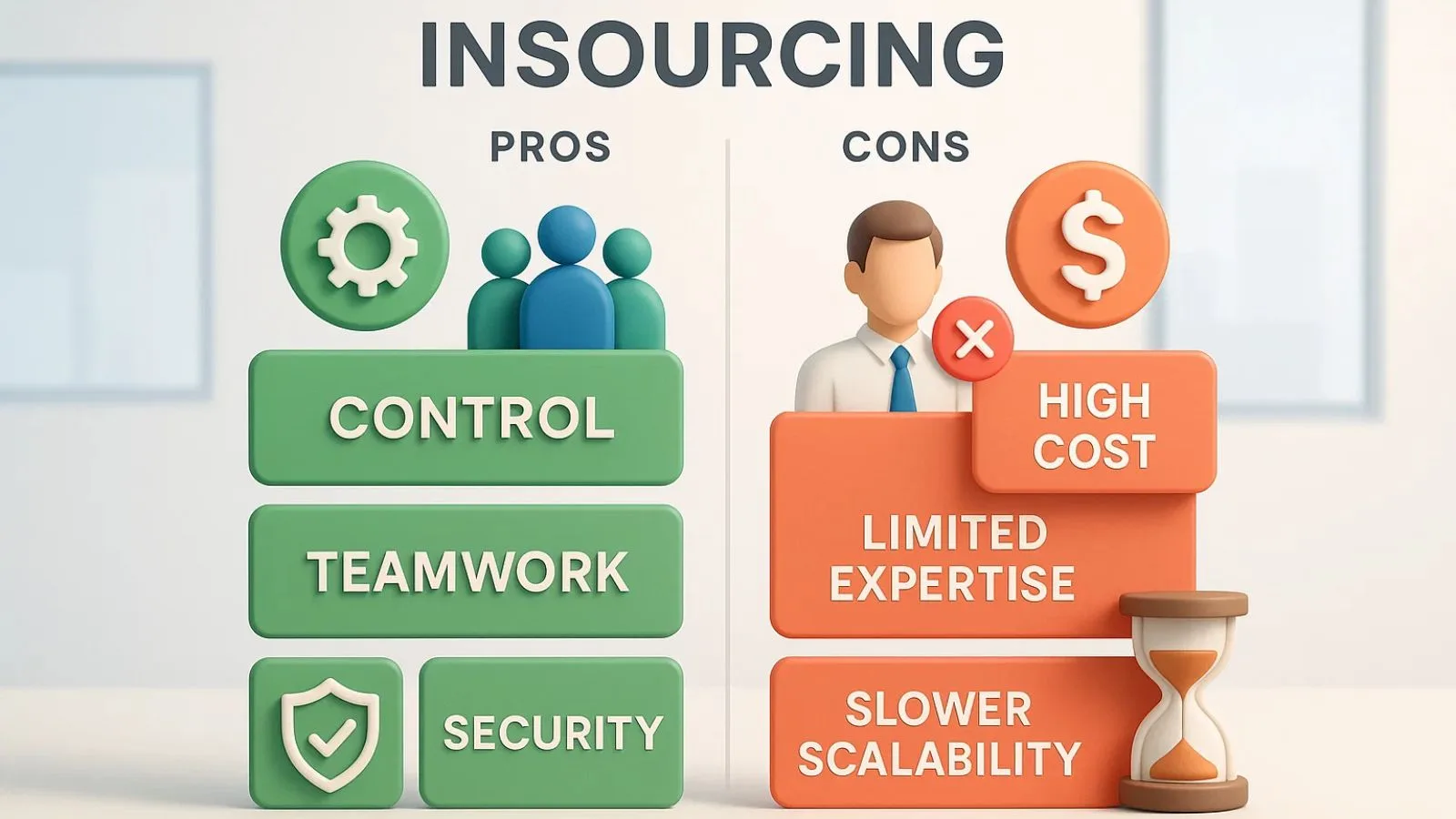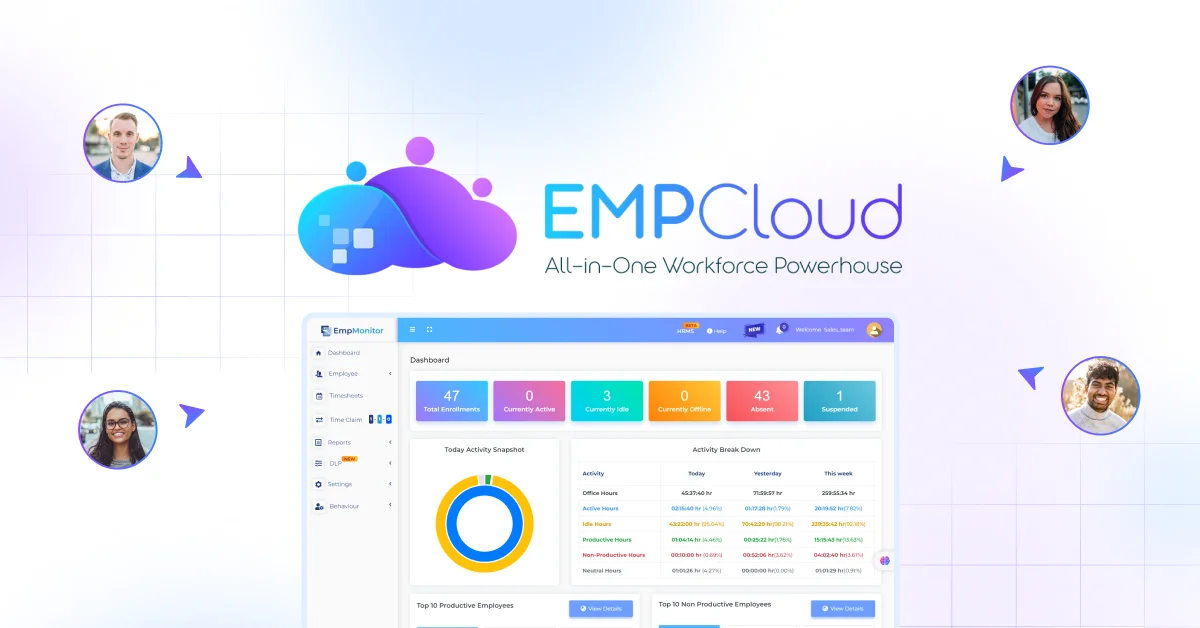
In today’s dynamic business world, companies are constantly looking for smarter ways to manage their workforce. One of the most important strategic decisions they face is choosing between insourcing vs outsourcing. Both models offer distinct advantages and challenges, impacting everything from hiring new joiners to long-term workforce management.
Insourcing focuses on building internal teams and handling projects in-house, giving companies more control and cultural alignment. Outsourcing, on the other hand, involves hiring external specialists or agencies to complete specific tasks, often offering cost efficiency and flexibility.
As businesses scale and recruitment needs evolve, understanding outsourcing vs insourcing becomes crucial to optimizing productivity and maintaining cost-effectiveness. In this blog, we’ll explore how each model works, compare their pros and cons, and help you decide which one fits your business best.
You can also listen to our Podcast here,
What Is Insourcing?
 Insourcing refers to the practice of managing business operations or projects internally, using a company’s existing employees and resources. Instead of delegating work to external vendors, organizations assign tasks to their in-house teams. This approach allows companies to maintain tighter control, better communication, and stronger alignment with business goals.
Insourcing refers to the practice of managing business operations or projects internally, using a company’s existing employees and resources. Instead of delegating work to external vendors, organizations assign tasks to their in-house teams. This approach allows companies to maintain tighter control, better communication, and stronger alignment with business goals.
In recruitment terms, insourcing involves new joinee hiring, employee enrollment, and team development within the organization. Companies that prefer insourcing often focus on building a skilled, long-term workforce capable of handling both routine and strategic operations.
The biggest advantage of insourcing is the level of familiarity and consistency it brings. Since employees are part of the company culture, they understand its values, quality standards, and internal workflows. This makes collaboration smoother and helps maintain accountability across departments.
Insourcing is especially useful for businesses that require confidentiality, close collaboration, or projects involving proprietary information. By keeping everything in-house, they ensure data security and quality control.
What Is Outsourcing?
 Outsourcing is the process of contracting external companies, agencies, or freelancers to perform specific business functions or projects. Instead of hiring full-time employees, organizations delegate tasks such as IT support, marketing, payroll, or customer service to external experts. This approach helps businesses save time, reduce costs, and access specialized skills they may not have internally.
Outsourcing is the process of contracting external companies, agencies, or freelancers to perform specific business functions or projects. Instead of hiring full-time employees, organizations delegate tasks such as IT support, marketing, payroll, or customer service to external experts. This approach helps businesses save time, reduce costs, and access specialized skills they may not have internally.
When comparing insourcing vs outsourcing, the latter is often preferred for short-term projects, specialized work, or when scaling operations quickly. Outsourcing allows companies to focus on their core business activities while external teams handle routine or technical tasks efficiently.
It’s also a flexible model that supports global collaboration. Businesses can hire professionals from different regions to manage operations across time zones, enabling 24/7 productivity. Moreover, outsourcing can be cost-effective—especially for startups or small businesses that can’t afford large in-house teams.
However, while outsourcing offers convenience, it may come with challenges like communication gaps, less control, and dependency on third-party vendors. Choosing the right partner and setting clear expectations is key to making this model successful.
Also read,
Key Differences — Insourcing vs Outsourcing
 Understanding the core differences between insourcing vs outsourcing helps businesses choose the right model for their goals, budget, and operations. While both aim to improve efficiency and productivity, they differ significantly in execution, control, and workforce management.
Understanding the core differences between insourcing vs outsourcing helps businesses choose the right model for their goals, budget, and operations. While both aim to improve efficiency and productivity, they differ significantly in execution, control, and workforce management.
Here’s a quick breakdown of the major distinctions between insourcing and outsourcing:
| Aspect | Insourcing | Outsourcing |
| Workforce Control | High – managed internally with direct supervision. | Low – handled by external vendors or contractors. |
| Cost | Higher long-term costs due to salaries, benefits, and training. | Lower upfront cost; payment based on contract or project. |
| Expertise | Relies on internal employee skills and development. | Access to external experts with specialized skills. |
| Flexibility | Less flexible in scaling up or down quickly. | Highly flexible and adaptable to changing project needs. |
| Cultural Alignment | Strong company culture and consistent values. | May face cultural or communication barriers. |
| Confidentiality | Data and processes stay within the company. | Potential data security risks with third parties. |
In short, outsourcing vs insourcing is not about which is better—it’s about which fits your business model. Insourcing gives you full control and long-term team growth, while outsourcing provides scalability and specialized expertise on demand.
Insourcing Pros and Cons
Like any business model, insourcing comes with both strengths and challenges. Understanding these helps organizations decide when it’s the right fit for their goals.
Pros of Insourcing
- Greater Control
Insourcing allows direct supervision over employees, processes, and project outcomes. Managers can make real-time decisions and maintain quality standards with ease. - Cultural Consistency
Since insourced teams are part of the company, they naturally align with its values, vision, and long-term goals. This leads to stronger collaboration and team cohesion. - Improved Communication
Working under the same management structure ensures smoother communication between departments, leading to faster decision-making and fewer misunderstandings. - Confidentiality and Security
Sensitive company information remains within internal systems, reducing risks of data breaches or intellectual property leaks. - Employee Growth and Loyalty
Insourcing encourages internal career growth and upskilling, helping retain talent through structured employee enrollment and development programs.
Cons of Insourcing
- Higher Costs
Maintaining full-time staff requires higher expenses, including salaries, training, benefits, and infrastructure. - Limited Expertise
Internal teams may lack specialized skills for specific projects, requiring additional training or hiring. - Slower Scalability
Expanding internal teams to meet new demands takes time—recruitment, onboarding, and training can delay execution.
Overall, understanding the sourcing pros and cons helps companies balance long-term control with operational efficiency.
Outsourcing Pros and Cons
Outsourcing offers a different set of advantages and challenges compared to insourcing. For many companies, it’s a practical solution to meet dynamic business demands without overburdening internal resources.
Pros of Outsourcing
- Cost Efficiency
Outsourcing helps reduce operational expenses by eliminating the need for full-time hires, infrastructure, and employee benefits. Businesses pay only for the services they need. - Access to Specialized Expertise
External partners often have niche skills and advanced tools, making it easier to execute complex projects efficiently—especially in areas like IT, marketing, or data analytics. - Scalability and Flexibility
One of the biggest benefits of insourcing vs outsourcing is flexibility. Outsourcing allows companies to scale up or down quickly based on project size or budget. - Faster Turnaround
Since many outsourcing teams work across different time zones, companies can achieve faster project completion and round-the-clock productivity. - Focus on Core Business
Delegating non-core activities to external teams allows internal employees to concentrate on strategic growth and innovation.
Cons of Outsourcing
- Reduced Control
External teams may not always align with company culture or quality expectations, making monitoring and supervision challenging. - Communication Barriers
Working with global teams can sometimes cause time zone conflicts or misunderstandings. - Data Security Risks
Sharing sensitive information with third parties can create potential security vulnerabilities. - Hidden Costs
While outsourcing seems cost-effective initially, additional fees for revisions, changes, or longer contracts can add up over time.
Ultimately, companies must evaluate both insourcing and outsourcing carefully to find the best fit for their business goals and resources.
Choosing Between Insourcing and Outsourcing
The right choice between insourcing and outsourcing depends on your business goals, resources, and priorities.
Insourcing is ideal for companies that value control, consistency, and internal growth. It works best for handling sensitive data, fostering employee development, and managing long-term or complex projects that need close supervision.
Outsourcing, on the other hand, suits businesses seeking flexibility, cost savings, and quick access to specialized skills—especially startups or fast-growing teams needing speed and scalability.
Many organizations now use a hybrid approach, combining insourcing for core operations with outsourcing for specialized tasks. Evaluating factors like project size, data sensitivity, and available talent will help you choose the most efficient model for your goals.
Role of Technology in Workforce Management
Technology plays a crucial role in streamlining both the insourcing vs outsourcing models. As businesses grow and diversify their teams, digital tools make it easier to manage operations, monitor productivity, and maintain seamless communication.
Modern employee monitoring software and workforce management software help organizations oversee projects, track performance, and ensure accountability—regardless of where employees are located. For insourced teams, these tools simplify daily workflows, improve collaboration, and make onboarding new joiners smoother. For outsourced teams, they ensure transparency, time tracking, and clear communication between internal managers and external vendors.
AI-powered platforms also assist in recruitment, helping HR teams identify the right talent faster. From employee enrollment to ongoing performance evaluation, technology ensures that businesses maintain efficiency and consistency across departments.
Ultimately, technology bridges the gap between insourcing and outsourcing, allowing companies to operate smarter, manage hybrid teams effectively, and maintain productivity across the board.
How Empcloud Simplifies Workforce Operations?
Managing a modern workforce—especially when balancing insourcing vs outsourcing—requires precision, visibility, and control. That’s exactly where Empcloud steps in.
Empcloud is an all-in-one workforce management software designed to streamline employee operations, boost productivity, and simplify HR processes. It provides real-time insights into employee activity, project status, and performance metrics—all through a single dashboard.
For companies using an insourcing model, EmpCloud enhances transparency by tracking attendance, automating payroll, and optimizing workflows across departments. It empowers managers to make data-driven decisions and ensure every team member is working efficiently.
Not only that EmpCloud provide HR solutions that help in employee recruitment, manage the onboarding process, and talent management, etc.
For those who rely on outsourcing, EmpCloud brings clarity to vendor operations. It helps businesses monitor outsourced tasks, manage deadlines, and ensure quality output. The system’s automated reports and intelligent analytics allow HR teams to identify bottlenecks early and take corrective actions swiftly.
From employee engagement to performance tracking, Empcloud simplifies every step of workforce management. By leveraging its automation and AI-driven analytics, businesses can maintain control, improve efficiency, and make smarter decisions—no matter where their teams are based.
Also read,
How To Master Recruitment And Selection For Top Talent?
Conclusion
The debate around insourcing vs outsourcing isn’t about which is better but which suits your business strategy best. Insourcing gives you greater control, deeper engagement, and stronger alignment with company goals. Outsourcing, on the other hand, helps you scale quickly, reduce costs, and access specialized expertise without overloading your internal teams.
A balanced approach often works best—build a skilled in-house core team while outsourcing tasks that require niche talent or rapid delivery. And with advanced workforce tools like Empcloud, businesses can streamline recruitment, track performance, and optimize workforce management—making both insourced and outsourced operations seamless and efficient.
FAQs on Insourcing vs Outsourcing
- Can a company use both insourcing and outsourcing at the same time?
Yes, many companies adopt a hybrid approach—keeping core functions insourced for control and brand consistency while outsourcing non-core tasks to improve efficiency and cost-effectiveness. - How does technology impact insourcing vs outsourcing decisions?
Modern tools like AI, cloud platforms, and workforce management software make it easier to collaborate with outsourced teams and monitor productivity, reducing traditional outsourcing challenges. - What are the hidden costs of outsourcing?
While outsourcing may seem cheaper initially, hidden costs like communication gaps, time zone differences, vendor management, and quality control can add up over time.


